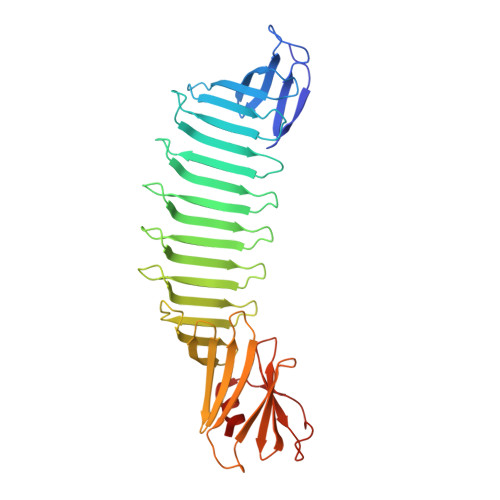Minimalist design of water-soluble cross-{beta} architecture.
Biancalana, M., Makabe, K., Koide, S.(2010) Proc Natl Acad Sci U S A 107: 3469-3474
- PubMed: 20133689
- DOI: https://doi.org/10.1073/pnas.0912654107
- Primary Citation of Related Structures:
3CKA, 3EEX - PubMed Abstract:
Demonstrated successes of protein design and engineering suggest significant potential to produce diverse protein architectures and assemblies beyond those found in nature. Here, we describe a new class of synthetic protein architecture through the successful design and atomic structures of water-soluble cross-beta proteins. The cross-beta motif is formed from the lamination of successive beta-sheet layers, and it is abundantly observed in the core of insoluble amyloid fibrils associated with protein-misfolding diseases. Despite its prominence, cross-beta has been designed only in the context of insoluble aggregates of peptides or proteins. Cross-beta's recalcitrance to protein engineering and conspicuous absence among the known atomic structures of natural proteins thus makes it a challenging target for design in a water-soluble form. Through comparative analysis of the cross-beta structures of fibril-forming peptides, we identified rows of hydrophobic residues ("ladders") running across beta-strands of each beta-sheet layer as a minimal component of the cross-beta motif. Grafting a single ladder of hydrophobic residues designed from the Alzheimer's amyloid-beta peptide onto a large beta-sheet protein formed a dimeric protein with a cross-beta architecture that remained water-soluble, as revealed by solution analysis and x-ray crystal structures. These results demonstrate that the cross-beta motif is a stable architecture in water-soluble polypeptides and can be readily designed. Our results provide a new route for accessing the cross-beta structure and expanding the scope of protein design.
- Department of Biochemistry and Molecular Biology, The University of Chicago, IL 60637, USA.
Organizational Affiliation:

















